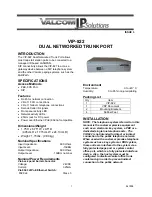
Chapter 3 Operation
10
E1 can be used in two frame or multiframe mode. If CRC is OFF, 2 frame format results. If CRC is ON, 16
frame format results. For E1, the cyclic redundancy check function can be turned ON or OFF. Unlike
bipolar violation, which can monitor only one span, CRC allows error monitoring through multiple spans of
DS0 lines. For E1, if CAS is ON, a 16-frame structure is used, which is independent of the 16-frame
structure for CRC. A proprietary facility data link is implemented in both modes to facilitate remote system
control and performance and statistics monitoring.
For DS1, the CRC function is embedded in the ESF frame format, which if chosen, is always on.
3.9.1.5 Facility Data Link - In-Band Signaling
A proprietary facility data link, FDL, is used for E1 and in-band signaling is used for DS1, to achieve
remote system control and performance and statistics monitoring.
3.9.1.6 AIS
AIS, alarm indication signal, notifies the far end that a loopback and diagnostic test are in progress. Thus
customer signals are blocked. The AIS can be sent two ways. In the framed mode, all time slots will have
all ones sent but the framing pattern will be preserved. In the unframed mode, all ones are sent for all time
slots.
3.9.1.7 CAS
For voice channels, the signaling information, which included such signals as on-hook, and ringing, can be
carried by two methods. One is by a completely independent channel managed by the system operator, in
which case no action is needed by the local equipment (CAS is OFF). Another is by CAS where the
signaling information is carried in the same bit stream as the voice channel. In this second method, for time
slot interchange, the signaling bits must be routed along with the voice channels to the proper destination.
Thus the Loop unit must be told, when CAS is used, to turn the CAS option to ON. Setting MF to Off turns
CAS off. Setting MF to On turns CAS on.
For E1, CAS (Channel-Associated Signaling) is a method for sending signaling information where time slot
16 of the E1 format is shared for each of 30 other time slots within the same E1. OFF designation is for
CAS disabled. For E1, when disabled, the 256N multiframe is used when time slot 16 is available to the
user. The maximum number of time slots available for payload is 31. ON designation is for CAS enabled.
When enabled, the 256S multiframe is used when time slot 16 is reserved for the transmission for end-to-
end signaling using CAS. The maximum number of times slots available for payload is then 30.
For DS1, CAS, when ON, is where "robbed-bit signaling" takes place. This places the signaling information,
once every 6 frames, in bit 7 (least significant bit) of the associated time slot, replacing the information bit at
that location. When CAS is OFF, robbed-bit signaling will not take place. When ON, robbed-bit signaling
is permitted for voice channels. For channels designated as DATA, robbed-bit signaling is not performed.
3.9.1.8 Idle Code
Any DS0 time slot, which is not assigned to the WAN port, is an idle time slot. An idle code is transmitted on
idle DS0 time slots. The idle time slot may be programmed to any bit pattern from 0x00 to 0xFF. (The
prefix 0x is to indicate that hex follows.)
NOTE
: Due to ones-density requirement, it is advised that idle code be set as 0xD5 for E1 (which is the
factory default). Otherwise, the idle code must be programmed to contain at least two bits of '1'.
3.9.1.9 Loopback Timer
The Loopback Timer menu is used to set the loopback time. When a loopback is issued via the WAN port,
the WAN port will be unavailable while the loopback is in effect, and thus cannot be used to turn the
loopback off. If you are going to issue a loopback via the Wan port you
must
set the loopback timer for a
period (in seconds) suitable to your testing requirements. If you are not planning to do any loopback testing
via the WAN port, leave the timer at its default settling of “60” seconds.
Summary of Contents for IP6610
Page 2: ...2011 Loop Telecommunication International Inc All rights reserved Version 33 23 MAR 2011...
Page 76: ...Chapter 11 Port Forwarding Virtual Service 53...
Page 79: ...Chapter 12 QoS 56 Figure 12 1 QoS Application...
Page 119: ...Chapter 20 Setting Up Firmware Configuration Up Download with TFTP Server 96...
















































